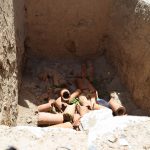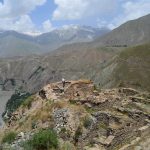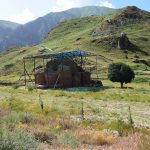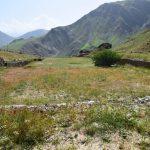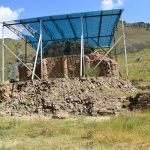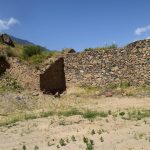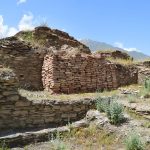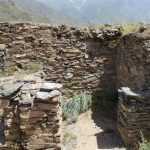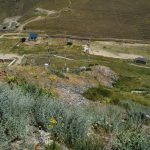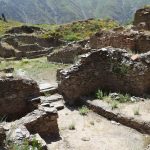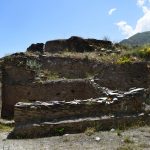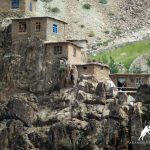Tucked away on a clifftop above the River Panj and the Pamir Highway in the Tajik Gorno-Badakhshan Autonomous Oblast (GBAO) region, the newly discovered Karon Palace, Tajikistan has been dubbed the ‘Machu Picchu of Tajikistan’. Not to be confused with the same-named Karon Palace Hotel Tajikistan in the town of Kalai Khum just five kilometers away, the high-altitude ancient city of Karon is a masterpiece that remained undiscovered for thousands upon thousands of years.
The fact that it remained hidden for so long may not be all that surprising when you consider that the population density in the GBAO region of Tajikistan is just one person for every 2.5 square kilometers. And despite its ancient size – measuring well over 100 hectares – the archeological site of Karon in Tajikistan blended in well with the surrounding landscape of the Pamir Mountains.
In fact, it was barely visible. Besides, at its location along a hairpin bend dug into the side of the cliff 2,000 meters above sea level, it would have required a steep trek or a climb in a 4×4 in scorching temperatures for someone to stumble across it by accident.
With the oldest structures dating back to the 2nd-Millenium BC, Karon Palace was only discovered in 2012 when a Tajik landowner found an odd-looking brick structure in the middle of the isolated Pamirs. Tajik and Russian archaeologists, particularly one by the name of Yusufsho Yukubov, were called to check it out and were amazed at what they found. Their studies revealed that among other notable features, Castle Karon, Tajikistan is home to the last surviving Zoroastrian water temple in Central Asia.
Comparable to Peru’s Machu Picchu, the Tajiks are hopeful that Karon Palace in the Vanj Valley will draw a new kind of traveler to the country. Because it was hidden for so long, it has been lovingly dubbed the Lost City of Tajikistan, or Karon Tajikistan’s Lost City, even though it is believed it was still lived in as recently as 500 years ago. Whatever you choose to call it, the ancient town of Karon had some fascinating archeological finds.
Located on a flat-topped plateau, Karon Castle is believed to have been surrounded by an enormous ancient polo field. It would have measured 30 meters wide and 50 meters long in its prime. The polo field had space for 10,000 spectators which tells us that the ancient city of Karon must have been much larger even than the size of all of the nearest modern-day towns put together.
Excavations and archaeological digs have continued for years after the initial discovery in 2012 and have uncovered the remains of ancient temples and churches, administrative buildings, residential houses, age-old mines, and a fragment of the holy book of the Zoroastrians that showed that these people were followers of Zoroastrianism (fire worshipping). Signs of blood sacrifices suggest that the cult of Mithraic Mysteries was also practiced here.
Other finds of Karon Tajikistan’s archeology include a well-preserved stoneware pot and a burnt niche that very likely also had Zoroastrian connections. Located along the caravan trading trail to Khorog in Tajikistan, it is evident that the residents of Karon Palace were religious people that made their money through Silk Road trading and by mining and processing gold.
Climbing to the top of the old city is truly rewarding. You will be able to see hordes of multi-story buildings with their staircases intact and wide streets with a backdrop that is very similar to Machu Picchu. It is estimated that it will take decades more to fully uncover the remains of this remarkable four-thousand-year-old Tajik city.
If you are excited to explore Karon Tajikistan’s Lost City, you can combine this with many other attractions and trekking routes along the Pamir Highway when you book a tour with Paramount Journey. Take a look at our itineraries for possible tours and itineraries in Tajikistan.






